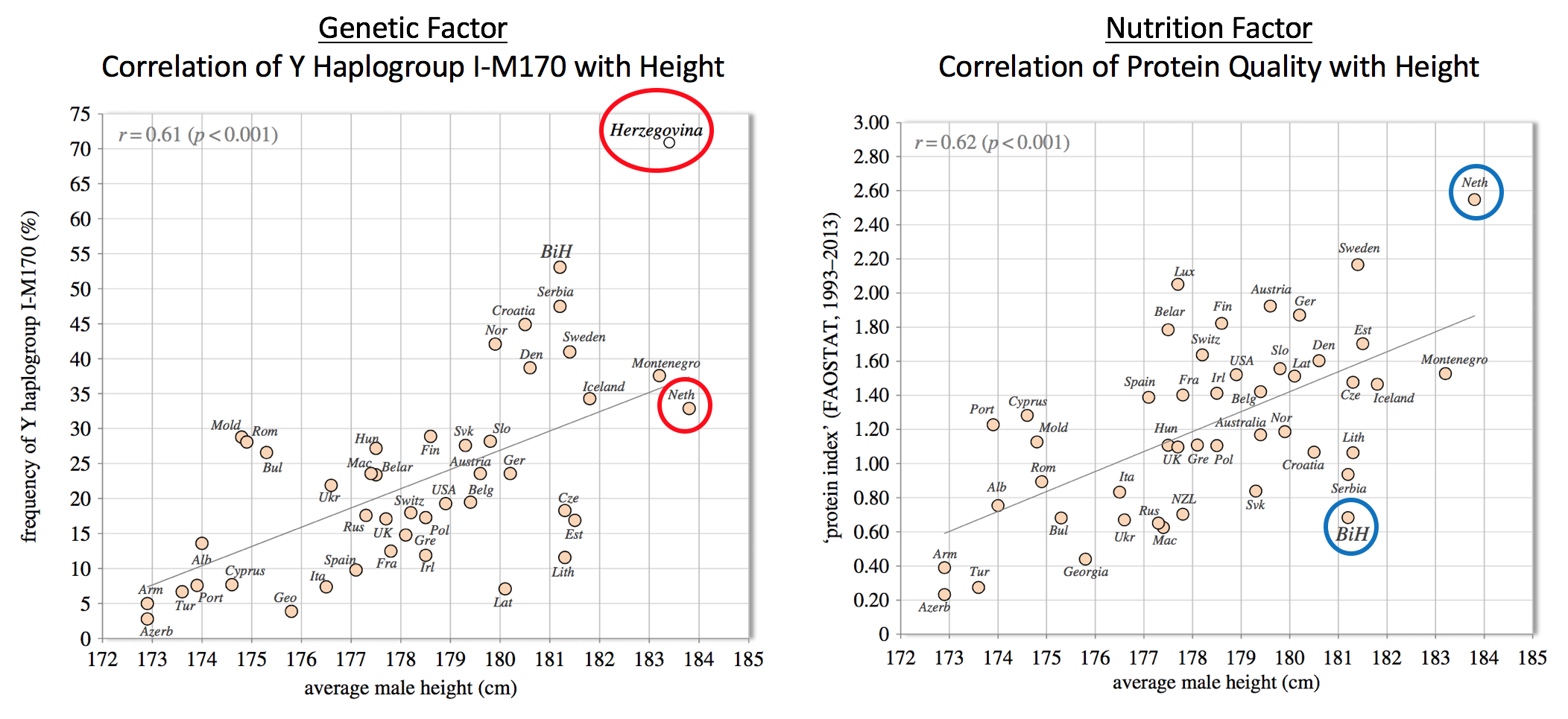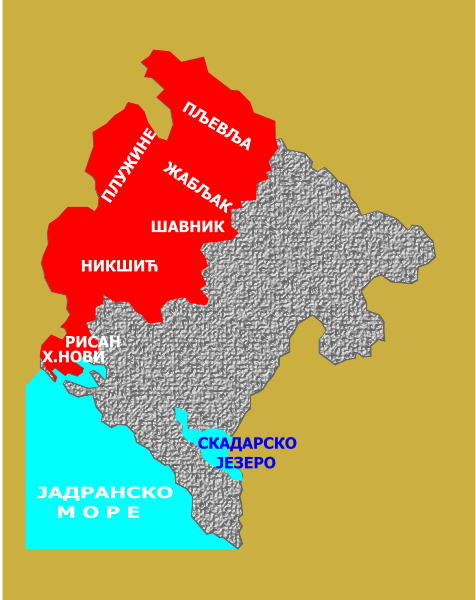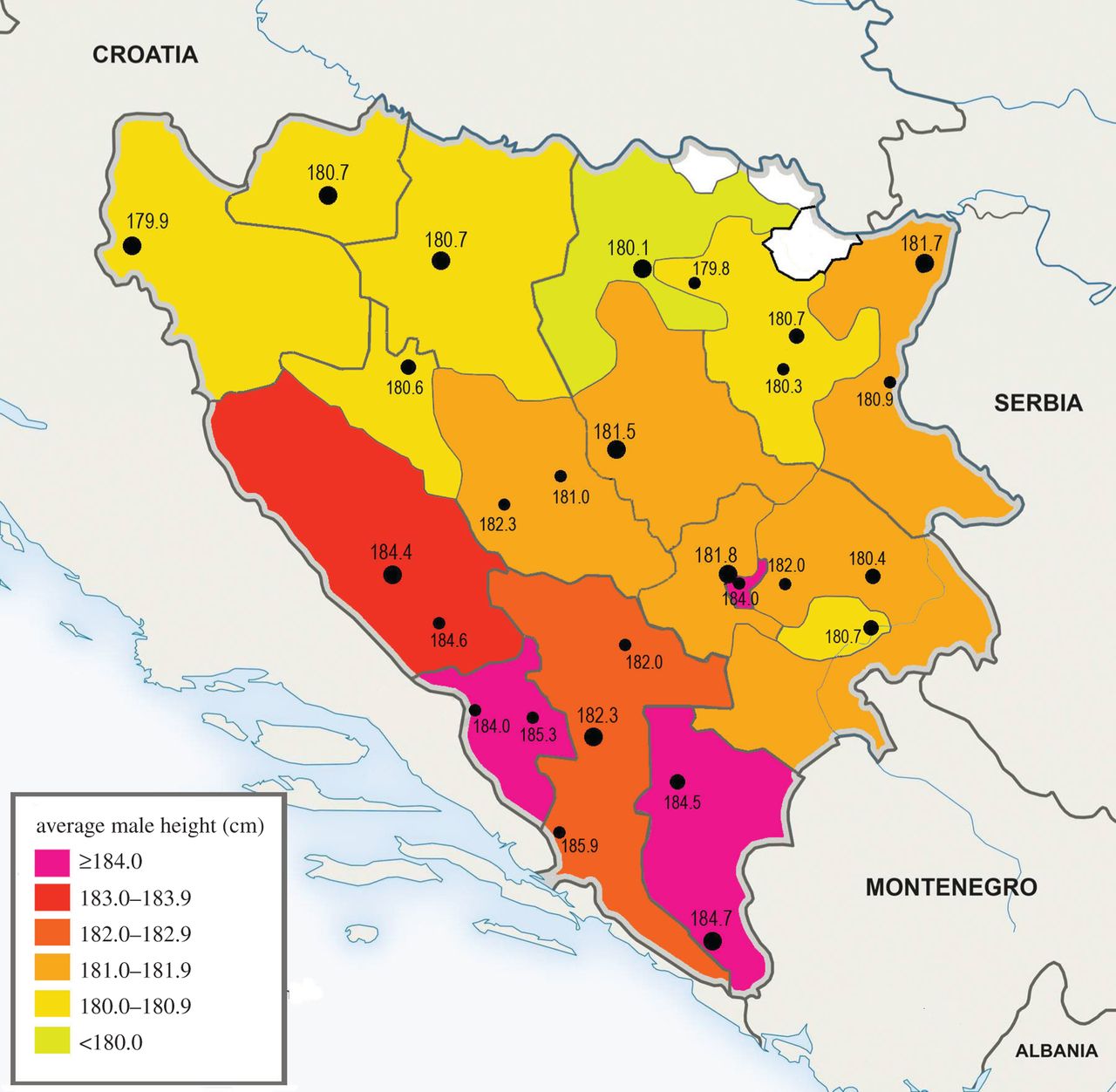Ovo pitanje sve vise zaokuplja i svetsku naucnu javnost koja se bavi takvim temama. Primera radi, svez rad koji se pojavio
US National Library of Medicine
National Institutes of Health
Zvanicna drzavana institucija SAD koja se bavi medicinskim podacima.
Naziv naucnog rada:
The mountains of giants: an anthropometric survey of male youths in Bosnia and Herzegovina
https://www.ncbi.nlm.nih.gov/pmc/articles/PMC5414258/
Ali genetsko objasnjenje ne moze tako lako da prodje jer ljudi u Doboju se ne razlikuju toliko genetski od onih u Trebinju da bi razlika prosecne visine bila skoro 5 cm.
Zanimljivo je kako regionalno visina varira u CG i Hrvatskoj. Srbija je vec drugojacija jer je masivno dinarizovana od 18 veka do danas i samo je jugo-istok i istok izuzetak tih talasa i naravno to se odrazava na visini ali u Hrvatskoj je to vise regionalno izrazeno.
Jedna zanimljivost. Kada bi se ljudi u Dinarskom masivu hranili kao u Holandiji bili bi za 5-10 cm visociji u proseku nego danas.


US National Library of Medicine
National Institutes of Health
Zvanicna drzavana institucija SAD koja se bavi medicinskim podacima.
Naziv naucnog rada:
The mountains of giants: an anthropometric survey of male youths in Bosnia and Herzegovina
https://www.ncbi.nlm.nih.gov/pmc/articles/PMC5414258/
The aim of this anthropometric survey, conducted between 2015 and 2016 in Bosnia and Herzegovina (BiH), was to map local geographical differences in male stature and some other anthropometric characteristics (sitting height, arm span). In addition, to investigate the main environmental factors influencing physical growth, the documented values of height would be compared with available nutritional and socioeconomic statistics. Anthropometric data were collected in 3192 boys aged approximately 18.3 years (17–20 years), from 97 schools in 37 towns. When corrected for population size in the examined regions, the average height of young males in BiH is 181.2 cm (181.4 cm in the Bosniak-Croat Federation, 180.9 cm in Republika Srpska). The regional variation is considerable—from 179.7 cm in the region of Doboj to 184.5 cm in the region of Trebinje. These results fill a long-term gap in the anthropological research of the Western Balkans and confirm older reports that the population of the Dinaric Alps is distinguished by extraordinary physical stature. Together with the Dutch, Montenegrins and Dalmatians, men from Herzegovina (183.4 cm) can be regarded as the tallest in the world. Because both nutritional standards and socioeconomic conditions are still deeply suboptimal, the most likely explanation of this exceptional height lies in specific genetic factors associated with the spread of Y haplogroup I-M170. The genetic potential for height in this region could then be the greatest in the world. Future studies should further elucidate the roots of this intriguing phenomenon, which touches an important aspect of human biodiversity.
Ali genetsko objasnjenje ne moze tako lako da prodje jer ljudi u Doboju se ne razlikuju toliko genetski od onih u Trebinju da bi razlika prosecne visine bila skoro 5 cm.
Zanimljivo je kako regionalno visina varira u CG i Hrvatskoj. Srbija je vec drugojacija jer je masivno dinarizovana od 18 veka do danas i samo je jugo-istok i istok izuzetak tih talasa i naravno to se odrazava na visini ali u Hrvatskoj je to vise regionalno izrazeno.
Jedna zanimljivost. Kada bi se ljudi u Dinarskom masivu hranili kao u Holandiji bili bi za 5-10 cm visociji u proseku nego danas.





 by Zuper Sat 30 Sep - 20:26
by Zuper Sat 30 Sep - 20:26
 wrote:Visoki su da bi mogli da štite obruč, valjda je toliko jasno...
wrote:Visoki su da bi mogli da štite obruč, valjda je toliko jasno...



 prilicno vise izdzigljali od onih dole. Mada tu verovatno ima do ishrane...
prilicno vise izdzigljali od onih dole. Mada tu verovatno ima do ishrane...
 ; Tijana Boskovic, upravo razvalila Turkinje u odbojci visina 1.93m iz Trebinja...
; Tijana Boskovic, upravo razvalila Turkinje u odbojci visina 1.93m iz Trebinja...
 Erős Pista
Erős Pista